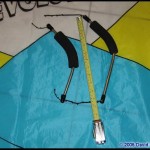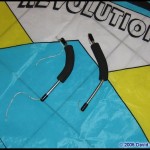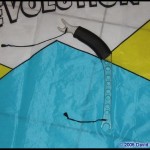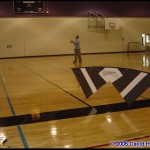So, with this issue, I’ll wrap up some of the basic things newish Rev flyers may want to know about. Keep in mind that there is as many differing opinions on all of this as there is quad flyers, so, keep an open mind and try everything you can, and decide for yourself.
Some days, I think there are as many variations on quad kite handles as there are separate quad kites and there’s probably just as many opinions with respect to “what works best”. Short ones, extra length ones, graphite wrapped ones, plastic ones and homemade ones are all very common. There’s a general rule of thumb at play with this. The longer your handles are, the more sensitive they become in transmitting your hand movements to the kite. The angle of the handles also comes into play with this. The sharper the angle, the more “throw” you will get as you rotate your wrists forwards and back while flying. So, lets take a look at the more common handles you will be likely to run across:
Rev 1/1.5 SLE Standard
 The most typical handle out there is what comes stock with most 1.5 SLE and Rev 1 kites. They are great all around handles that you can use for any quad (non-power) on the market with good success. They measure 10 inches from black tip to black tip and have a very firm Hypalon (which is used in fishing pole grips) foam grip that never seems to wear out. I can still use my original set that I got with my first Rev 1.5 about 8 years ago. One note, the handles that come with the EXP series kites -are- a little different. Length-wise, they are the same. However the foam is lighter and less firm than ones that come with the higher-end Revolutions.
The most typical handle out there is what comes stock with most 1.5 SLE and Rev 1 kites. They are great all around handles that you can use for any quad (non-power) on the market with good success. They measure 10 inches from black tip to black tip and have a very firm Hypalon (which is used in fishing pole grips) foam grip that never seems to wear out. I can still use my original set that I got with my first Rev 1.5 about 8 years ago. One note, the handles that come with the EXP series kites -are- a little different. Length-wise, they are the same. However the foam is lighter and less firm than ones that come with the higher-end Revolutions.
Rev II Handles
 At the short end of the spectrum are the Rev II handles, which measure 9 inches from tip to tip. These can be particularly handy in very high winds, or if you are dealing with stacked Revolutions. I don’t think they actually make these handles any longer, however you can often find sets of them in kite stores or on eBay without too much difficulty. I keep a set handy (non intentional pun 😉 because they also work well as “training handles”.
At the short end of the spectrum are the Rev II handles, which measure 9 inches from tip to tip. These can be particularly handy in very high winds, or if you are dealing with stacked Revolutions. I don’t think they actually make these handles any longer, however you can often find sets of them in kite stores or on eBay without too much difficulty. I keep a set handy (non intentional pun 😉 because they also work well as “training handles”.
Rev SUL/SUL Graphite
Sooner or later, and often sooner, Rev flyers move to the extended handles. They are usually called SUL handles and older sets are the same stainless steel as the standard handles, but you’ll also find graphite wrapped ones as well. A little longer at 12 inches tip to tip, they allow for a little more sensitivity in kite control and thus, have become everyone’s favorites to use. They are especially useful in low wind, giving you that extra bit of control that will make the difference between a frustrating low wind day and one where you spend much of it flying.
The graphite handles were initially seen with the introduction of the Blast series of kites, where the extra strength of the graphite wrap is helpful with a kite that can pull you along quickly, but be aware that the Power Blast handles do have a slightly relaxed angle to them, so watch for this when you buy a set. Also, the graphite handles use a slightly wider diameter for the foam on the handles. My personal preference is the original steel SUL handles simply because of the small foam grips. I suppose I’ll adapt to the graphite wrapped ones at some point, because, they DO look sexier.
Rev Indoor Handles
The newest handles to come out of Revolution have been the indoor handles. Stripped of the hog buckles on the tips and comprised of graphite, only with no steel core, these are VERY light handles. Due to their extra length, 14 inches of extra length, they are also extremely sensitive, which is exactly what you are looking for in an indoor kite, whether its a converted 1.5 or Revolution’s own Indoor kite.
Other Variations
 In the last two photos, we have two other “takes” on quad handles, the TC Ultra handles and the exotic Guildworks handles. I had originally gotten a set of the TC Ultra handles (which may or may not still be available anywhere. I haven’t seen a set in years besides my own) when I’d picked up one of the original TCs years ago. They are quite functional, and at 12 inches, they behave roughly like the SUL Rev handles. They always felt weird in my hands as the grip itself is more of a rounded rectangle. Your mileage may vary if you can find a set of these.
In the last two photos, we have two other “takes” on quad handles, the TC Ultra handles and the exotic Guildworks handles. I had originally gotten a set of the TC Ultra handles (which may or may not still be available anywhere. I haven’t seen a set in years besides my own) when I’d picked up one of the original TCs years ago. They are quite functional, and at 12 inches, they behave roughly like the SUL Rev handles. They always felt weird in my hands as the grip itself is more of a rounded rectangle. Your mileage may vary if you can find a set of these.
 And lastly, the mysterious Deca handles, made by Guildworks. I confess, I bought these based solely on looks. Anyone who owns more than one Synergy Deca will notice they usually have unique handle sizes with each particular kite. These handles were meant to address this, providing a multitude of adjustment points along line. You’d think from looking at them, that they would be somewhat fragile but, that’s not the case. They are sprung tightly and it’d take quite the force to break them. My initial use of them was indoors, but, I found that line tended to easily get caught up on the adjustment points. Also, as they are meant for a symmetrical kite, they don’t really have the angle needed towards the back of the kite’s tips. Useable, but, probably my least favorite set of handles, at least when connected to a Revolution. However, they sure do look cool. As far as I am aware, Guildworks doesn’t make these any longer and it has also been a long time since I have seen a set in person.
And lastly, the mysterious Deca handles, made by Guildworks. I confess, I bought these based solely on looks. Anyone who owns more than one Synergy Deca will notice they usually have unique handle sizes with each particular kite. These handles were meant to address this, providing a multitude of adjustment points along line. You’d think from looking at them, that they would be somewhat fragile but, that’s not the case. They are sprung tightly and it’d take quite the force to break them. My initial use of them was indoors, but, I found that line tended to easily get caught up on the adjustment points. Also, as they are meant for a symmetrical kite, they don’t really have the angle needed towards the back of the kite’s tips. Useable, but, probably my least favorite set of handles, at least when connected to a Revolution. However, they sure do look cool. As far as I am aware, Guildworks doesn’t make these any longer and it has also been a long time since I have seen a set in person.
Of course, those of you who are handy with tools can make your own handles as well with very little fuss and bother, or simply modify your existing handles. My REVisions article from Issue 43 covers how to add extra knots to the pigtails for tuning purposes. The current trend I’ve seen in videos of other Rev flyers, especially in Europe has been towards very long handles. While I have yet to try a pair with the length seen in these, I’m certainly going to sometime soon, just to see how much more control one can get. And on a final note, Sam Ritter was spotted at the AKA Convention this fall in Ocean Beach, flying with –no- handles, ala Lee Sedgwick. Attach the top line to your thumb, the bottom to your pinky and who needs stinkin’ handles anyways….
Who needs wind?
 While the vast majority of people who fly prefer to have some wind at their back when they go out, Revolutions are well suited to flying in no wind conditions as well, whether that’s inside a gym or outside on a quiet day. There’s a few things to be aware of that will make your no wind days a little more enjoyable, the first being short lines. If you are in a gym, your line length will be dictated by the height of the ceiling. Keep in mind that the length needs to be less than the total height of the gym, minus your own height with your arms outstretched over your head. This sounds obvious, but, the first indoor line set I made didn’t take that into consideration and I spent more time simply trying to avoid the girders and lamps above me.
While the vast majority of people who fly prefer to have some wind at their back when they go out, Revolutions are well suited to flying in no wind conditions as well, whether that’s inside a gym or outside on a quiet day. There’s a few things to be aware of that will make your no wind days a little more enjoyable, the first being short lines. If you are in a gym, your line length will be dictated by the height of the ceiling. Keep in mind that the length needs to be less than the total height of the gym, minus your own height with your arms outstretched over your head. This sounds obvious, but, the first indoor line set I made didn’t take that into consideration and I spent more time simply trying to avoid the girders and lamps above me.
If you are going to be outside, I’ve found lines that are between 15 and 30 feet to be ideal for no wind play while outside. With respect to the kite, you want it to be as light as you can possibly make it. If you can, start with an SUL model, with a 2 wrap frame (the ones marked “Professional Use Only”). You can also lose a few more grams by removing the protective rubber caps on the vertical rods where they connect to leading edge, or as an even more extreme measure, cut the end caps in half (warning, don’t use these for “regular” wind flying as you’ll find your rods may start falling out mid-air, which can be very dangerous for spectators and yourself). On my lightest 1.5 and 1, I have also replaced all the bungies with the lightest material I can find and if you can, track down one of the SUL bridles, or, get really adventurous and tie your own from some 50 pound spectra.
While we’re talking about bridles, you can also simply ditch the bridle altogether and attach your lines directly to the vertical caps. Or, take the easy route and use a Rev Indoor kite outdoors. Be aware that the Indoor is rated from 0 – 2 mph, and due to the light weight of the frame, they mean it. Much more than 2 mph will find you replacing your leading edge fairly quickly. The key here is to experiment and watch others to see how they handle their Revs in no wind conditions.
For an extreme look at flying with no wind, check out these guys from France and their “Street Kiting” videos. Where you fly is limited only by your imagination!
May the wind be at your back,
David Hathaway



